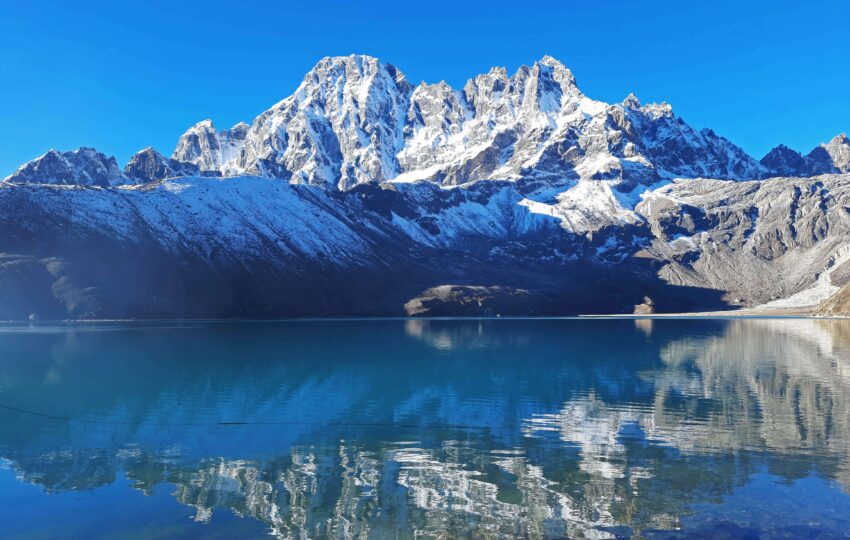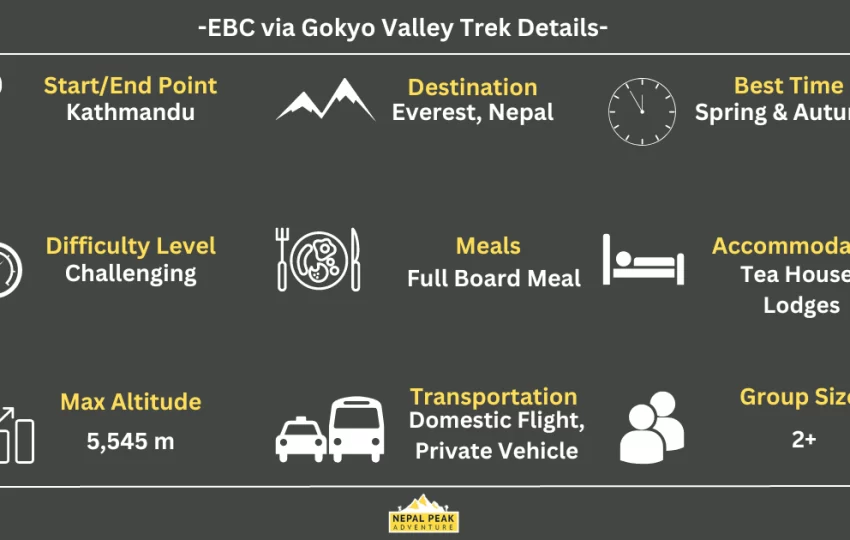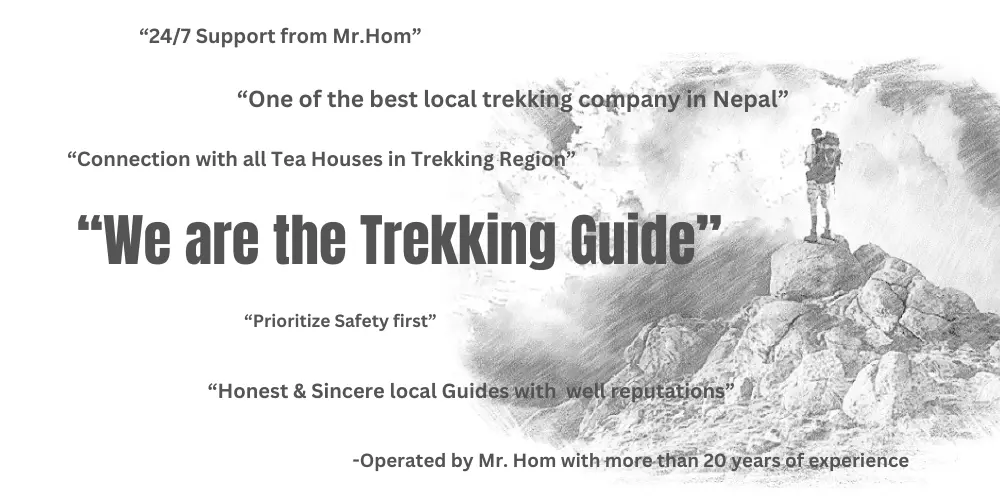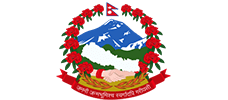Everest Base Camp via Gokyo Valley is the next level trek in the Khumbu Region that takes you to the beautiful Gokyo Lake, Gokyo-Ri, the opportunity to cross Cho La Pass, Kalapatthar, and of course the Everest Base Camp.
Within a 17-day plan, you only need to trek for 12 Days, there will be a Lukla flight, tea house accommodation, rest/acclimatization day, Full Board meals, a professional Guide, and many services that will help you to achieve your dream. Find out more about the package below:
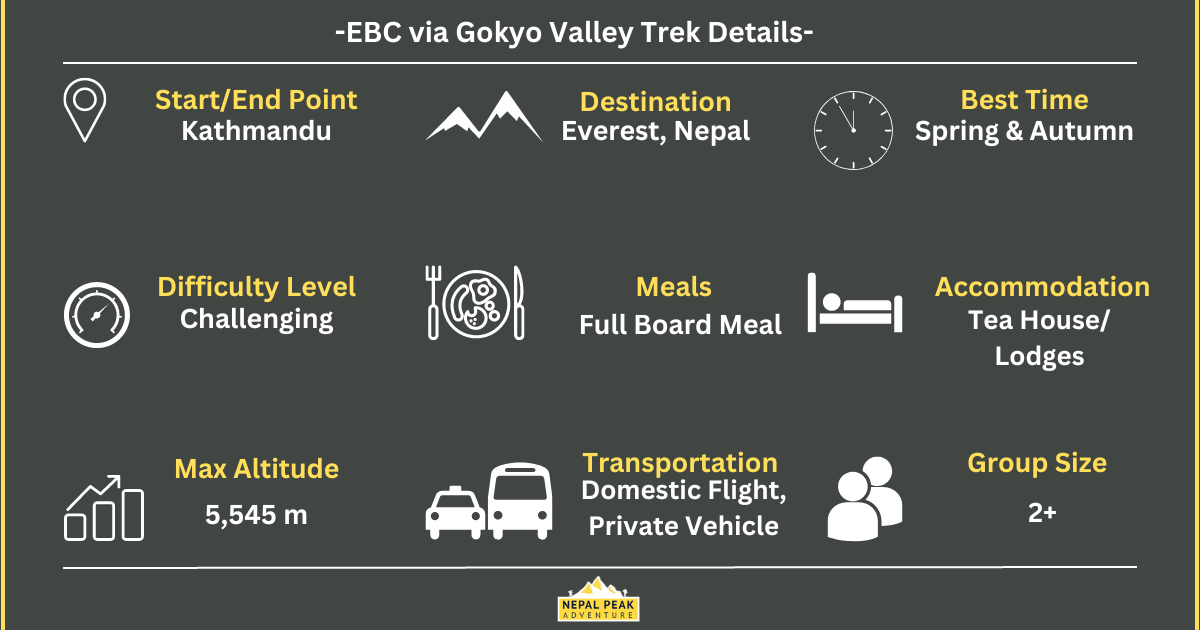
This trek is designed to provide ample chance for the trekkers to watch the tallest mountain on the globe, Mount Everest, including other towering peaks such as Mt. Cho-Oyu (8201m) and Mt. Lhotse (8516m). Apart from the general views of the mountains from the regular route; the trekkers will never get tired of watching the picturesque view of the wide range of the Himalayas from the famous viewpoints in the Khumbu region namely Gokyo Ri (5357m) and Kalapatthar (5643m).
EBC via Gokyo Valley Cost Inclusion & Exclusion
- Airport Pick-up and transfer to your booked hotel via Car/Jeep
- Welcome dinner with Nepal Peak Adv Crew at a reputed Nepali Restaurant that performs a live Nepali cultural program
- Up to 2 Nights Stay at 3-star standard accommodation in Thamel, Kathmandu based on Twin Sharing | B&B (Day 1 & Day 16)
- Two Way Flight Ticket for Kathmandu to Lukla & Lukla to Kathmandu (this applies during Off-Season)
- Or Two Way Flight Ticket for Ramechhap to Lukla & Lukla to Ramechhap (Apply on Spring & Autumn season) - Private Vehicle for Ramechhap Transportation will be arranged
- Teahouse/Mountain Lodge accommodation During the Trek | 5 nights with Attached Bathroom & Hot Shower Facility (1 night in Phakding, 3 nights in Namche, 1 night in Lukla) & 9 Days in Basic Accommodation
- Full Board Meals during Trek (Breakfast, Lunch, and Dinner)
- 3 cups of hot Tea/Coffee per day during the Trek
- Experienced Trekking Guide for the Trek & Insurance
- Sherpa Porter’s cost (One porter for every two members in a group) | Insurance & Salary
- Everest trekking permit/Sagarmatha National Park fee & Trekker Card
- Any other Government or Local tax included for the trek
- Down Jacket and Sleeping Bags (Upon request)
- A Company Duffle Bag (for the trek only) and a Company T-shirt (as a souvenir)
- Trekking map
- Certificate of Trek Completion from Company
- First Aid Kit + Unlimited Hydration Tablet
- The Arrangement of the Emergency Helicopter evacuation as per your Insurance Company
- Farewell Dinner at a reputable restaurant
- Final departure transfer
Cost Excludes
- Nepal Visa
- International flight to Kathmandu and a return ticket from Nepal.
- Your meal at Kathmandu besides welcome dinner, farewell dinner, and breakfast
- The entire cost of beverages (except hot drinks mentioned in the inclusion list), mineral water and beer, etc. while on the treks
- Travel insurance (must include Helicopter evacuation)
- Tipping to the guide and porter
- Anything not included in the trip inclusion list is your expenses
Everest Base Camp via Gokyo Valley Trek Itinerary:
Here is an outline itinerary of EBC via Gokyo Valley Trek:
- Day 1: Arrival day in Kathmandu (1400m)
- Day 2: Fly to Lukla and trek to Phakding (2610m)
- Day 3: Trek to Namche Bazar (3440m)
- Day 4: Acclimatization day at Namche Bazar (3440m)
- Day 5: Trek to Dole (4038m)
- Day 6: Trek to Machhermo (4470m)
- Day 7: Trek to Gokyo (4750m)
- Day 8: Acclimatization and rest day at Gokyo (4750m)
- Day 9: Hike to Gokyo-Ri (5,357m) and trek to Thagnag (4350m)
- Day 10: Cross Cho-La (5420m) and trek to Dzongla (4,830 m)
- Day 11: Trek to Lobuche (4,940 m)
- Day 12: Trek to Everest Base Camp (5364m) and return to Gorakshep (5164m)
- Day 13: Trek to Kalapatthar (5644m) and trek down to Periche (4371m)
- Day 14: Trek to Namche Bazar (3440m)
- Day 15: Trek to Lukla (2860m)
- Day 16: Fly back to Kathmandu (1400m)
- Day 17: Departure from Kathmandu (1400m)
Everest Base Camp Via Gokyo Trek Map
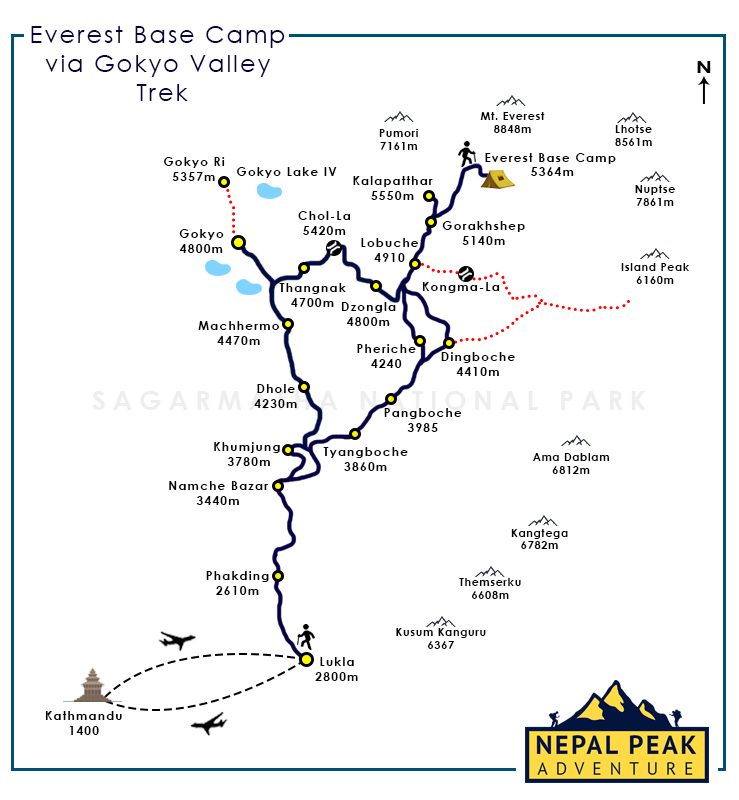
The Checkpoints of EBC via Gokyo Valley Trek
Lukla & Namche Bazar: Nestled amidst the Himalayas, Lukla stands as the thrilling threshold to the Everest region, captivating adventurers with its unique charm and breathtaking landscapes. With an elevation of 2860m, Lukla is the starting point for you.
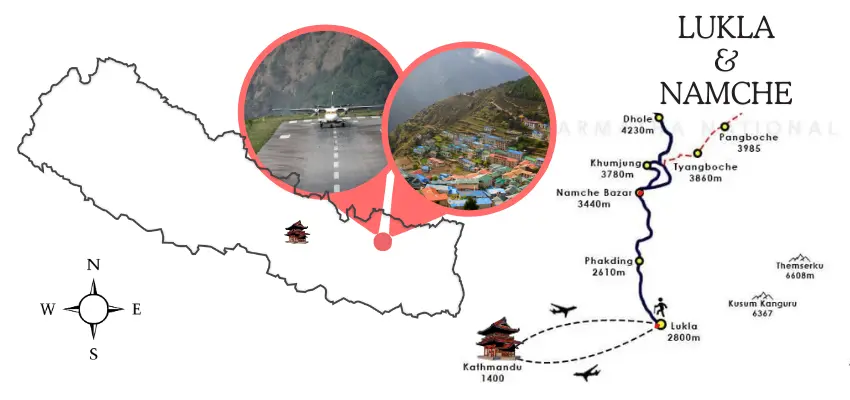
The journey begins with a spectacular flight to Tenzing-Hillary Airport, famously known as Lukla Airport – a heart-pounding experience as your plane navigates through the mountainous terrain to land on what is often considered one of the most challenging airports globally.
Whereas, Namche Bazaar stands as the gateway to the higher altitudes of Everest at an elevation of 3440 meters (11,352 feet). This bustling mountain town is not just a pitstop; it's a cultural and commercial hub, offering a blend of tradition and modernity.
Trekkers usually stop in Namche Bazar for a day to explore Local Markets, acclimatize in Everest View Hotel, visit the Sherpa Museum, or hike to Khumjung.
Gokyo Lake & Gokyo-Ri:
Gokyo welcomes trekkers with a chain of pristine lakes, each shimmering with a surreal turquoise hue. The series of lakes, including the renowned Dudh Pokhari, mirror the towering peaks that surround them. Gokyo Cho is the main lake with an area of 42.9 ha (106 acres), and the village of Gokyo lies on its eastern shore.
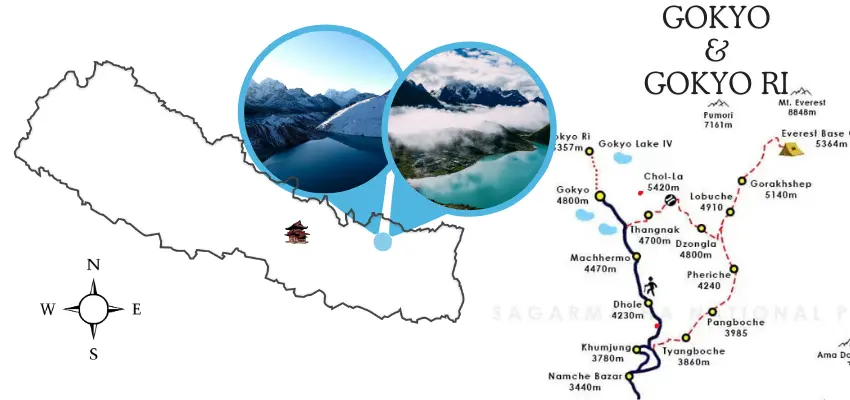
Whereas, Gokyo Ri stands as the ultimate vantage point standing at an elevation of 5,357 meters (17,575 feet). The ascent to Gokyo Ri is rewarded with a 360-degree spectacle of some of the world's highest peaks. As the sun kisses the snow-capped giants, Everest, Lhotse, Makalu, and Cho Oyu unveil their majesty, creating a canvas of unparalleled beauty.
However, the climb to Gokyo Ri is a challenging yet exhilarating journey which makes this package an exciting adventure.
Crossing Cho La Pass:
After ascending the Gokyo Ri, the next famous checkpoint in this package is crossing Cho La Pass. Perched at an elevation of 5,420 meters (17,782 feet), crossing Cho La Pass is a challenging trek that is not for the weak heart.
The true reward of conquering Cho La Pass unfolds as trekkers stand at its summit. Panoramic views greet them, revealing majestic towering peaks. Glaciers glisten in the sunlight, and the iconic summits of Ama Dablam, Cholatse, and Lobuche come into full view.
Everest Base Camp:
The dream of many trekkers, Everest Base Camp lies at an elevation of 5,364m (17,598 feet) above sea level. As trekkers stand amidst the rocky terrain, surrounded by towering peaks, the air is tinged with a sense of accomplishment and awe.
The iconic Khumbu Icefall, the starting point for Everest climbers, looms majestically, inviting trekkers to witness the epicenter of mountaineering history.
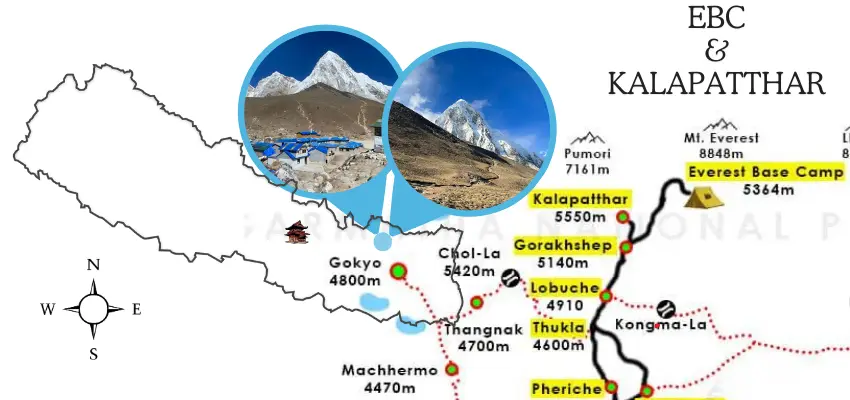
Kalapatthar:
Standing as a pinnacle of panoramic beauty, Kala Patthar is a Himalayan vantage point that beckons adventurers to its heights, offering an unrivaled spectacle of the world's highest peaks, with Mount Everest reigning supreme.
Perched at an elevation of 5,550 meters (18,209 feet), this iconic landmark is an essential stop for trekkers on the Everest Base Camp trail, promising an awe-inspiring sunrise experience and breathtaking views that etch themselves into the memory of all who venture to its summit.
Difference between Classic Everest Base Camp Trek & EBC via Gokyo Valley Trek:
In terms of differences between these two routes, the Classic EBC Trek follows the well-trodden path taken by legendary climbers (Tenzing Norgay Sherpa & Edmund Hillary) and trekkers. Whereas, EBC via the Gokyo Valley Trek route diverts to the serene Gokyo Valley, renowned for its turquoise lakes and the challenging Cho La Pass.
EBC via Gokyo Valley Trek is often chosen by those seeking a bit more challenge and off-the-beaten-path exploration, while the Classic Trek caters to those desiring a more established and traditional experience.
In choosing between these two magnificent journeys, trekkers must weigh their preferences – whether it's the classic charm of the well-trodden route or the allure of Gokyo's turquoise lakes and the challenge of Cho La Pass.
Gears & Equipment Needed for Everest Base Camp Gokyo Trek:
Gearing Up for EBC via Gokyo Valley Trek is similar to gearing up for a classic Everest Base Camp trek. With only adding some careful considerations of gear, you can ensure your comfort & safety in the trek. Here's a comprehensive list of essentials for your EBC via Gokyo Valley adventure:
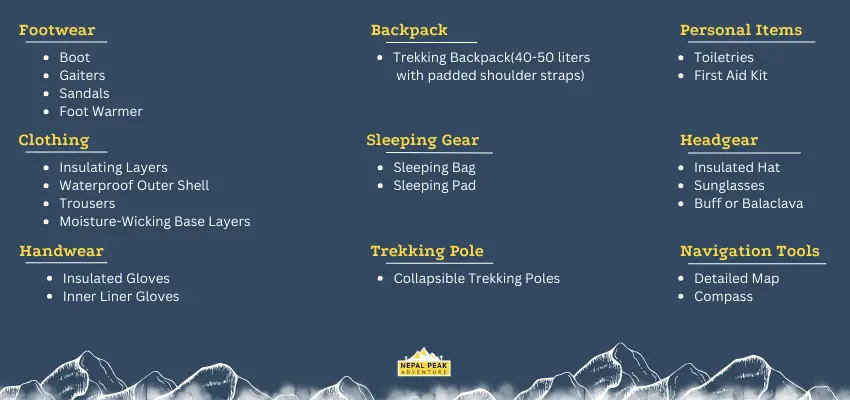
Footwear:
- Sturdy Full Trekking Boots: Waterproof and well-worn to prevent blisters, providing ankle support on uneven terrain. (1 pair)
- Gaiters: Protect lower legs from snow, water, and debris. (1 pair)
- Foot Warmer heat pack (optional)
- Sandals/shoes to wear inside the tea house (1 pair)
Clothing:
- Insulating Layers: Thermals (minimum 2), fleece jackets (min 2), and Down Jackets (1) for warmth in varying temperatures.
- Waterproof Outer Shell: Breathable, windproof, and waterproof jacket (1) and Trekking Pants for protection against rain and snow. (2)
- Trousers to wear inside the tea House (min 2)
- Moisture-Wicking Base Layers: Quick-drying fabrics to manage perspiration. (min 3)
Headgear:
- Insulated Hat: To retain warmth in cold temperatures.
- Sunglasses: UV-protective, glacier glasses to shield eyes from the intense mountain sun.
- Buff or Balaclava: For additional face and neck protection in chilly conditions.
Handwear:
- Insulated Gloves: Waterproof and windproof for warmth.
- Inner Liner Gloves: Lightweight for added insulation.
Backpack:
- Trekking Backpack: 40-50 liters with padded shoulder straps for comfort and compartments for organization.
Sleeping Gear:
- Sleeping Bag: Rated for sub-zero temperatures.
- Sleeping Pad: Insulated to provide a barrier from the cold ground.
Trekking Poles:
- Collapsible Trekking Poles: Aid in balance, reduce strain on knees during descents, and provide stability on uneven terrain.
Navigation Tools:
- Detailed Map: Essential for route planning and understanding the trek's topography. (Will be provided by Company)
- Compass: A backup for navigation.
Personal Hygiene and First Aid:
- Toiletries: Toothbrush, toothpaste, biodegradable soap, towel, and other personal hygiene items.
- First Aid Kit: Bandages, antiseptic creams, pain relievers, altitude sickness medication, and any personal prescription medications. (Will be provided by Company)
Water and Filtration:
- Water Bottles: Insulated bottles to prevent freezing in cold temperatures.
- Water Purification System: Filtration or purification tablets to ensure safe drinking water.
Electronics:
- Headlamp/Flashlight: With extra batteries for early morning or late-night treks.
- Camera: Capture the stunning landscapes, ensuring you have enough memory cards and batteries.
Miscellaneous:
- Duct Tape: A versatile tool for quick fixes.
- Multi-Tool or Knife: Handy for various tasks on the trail.
- Energy Snacks: High-energy snacks to fuel your trek.
Travel Insurance:
- Comprehensive Travel Insurance: Covering medical emergencies, evacuation, trip cancellations, and trek-related risks.
Preparation and Packing Idea:

- Layering is Key: Weather in the Himalayas can be unpredictable. Dress in layers to adapt to changing temperatures.
- Weight Distribution: Distribute weight evenly in your backpack to maintain balance during the trek.
- Break-in New Gear: Ensure boots and other gear are well-worn and comfortable before the trek.
- Altitude Considerations: Pack medications for altitude sickness and be attentive to symptoms during the trek.
Paying attention to the specific demands of this route, especially the high-altitude challenges, will contribute to a successful and memorable Himalayan adventure.
Insight to EBC Gokyo Trek:
So, what does it feel like to walk in the Everest Base Camp Gokyo Valley Trek route? How does your journey begin with Nepal Peak Adventure? Let’s talk about everything in this section.
Booking with Nepal Peak Adventure:
Let’s say you are ready to book with Nepal Peak Adventure, so you may ask what is the process for booking and what roles Nepal Peak Adv will play. So, the first thing is the detailed information that Nepal Peak Adventure will provide you about itinerary, departure dates, cost breakdown, and any other questions that you may ask.
After you are satisfied with your inquiry, you will then proceed with the online booking process reserving your seat with us which you can find in any package. Or, you can directly go to the online payment system for partial payment and pay only 25% of the total price.
We will then ask for some documents like your arrival dates in Nepal, and passport details to book a Lukla flight, reserve hotels in Kathmandu, and book tea houses.
First Day of Your Arrival: Renting Gears & Briefing
Airport Welcome: As per your arrival date, the Nepal Peak Adventure crew will extend a warm welcome upon your arrival at Kathmandu International Airport. After clearing immigration and collecting your luggage, you will be escorted to your hotel in Kathmandu. If you want to know how to get On Arrival Visa in Nepal then follow the steps:
- Fill out the 'Arrival Card' upon arrival.
- Complete the 'Tourist Visa' Application
- Fill out the 'Tourist Visa' form online. You can either fill it out before your arrival by visiting the official website of the Department of Immigration or use the kiosk machines upon your arrival at the airport.
If you choose to fill out the form online, you will receive a submission receipt with a barcode. Print out the receipt and bring it with you to acquire the visa. This receipt is valid for fifteen days; after that, it becomes invalid, and you will need to fill out the form again.
Proceed to the bank to make the required payment based on your visa duration (15/30/90 days).
Obtain the payment receipt for your records.
Hotel Check-in:
- Upon reaching your hotel, you will have the opportunity to freshen up and rest after your journey.
Trek Briefing:
- In the afternoon or evening, you will attend a comprehensive trek briefing conducted by your trekking guide or by Mr. Hom Rana.
- The briefing covers essential aspects of the trek, including the itinerary, trekking route, expected weather conditions, and safety protocols.
Gear Rental:
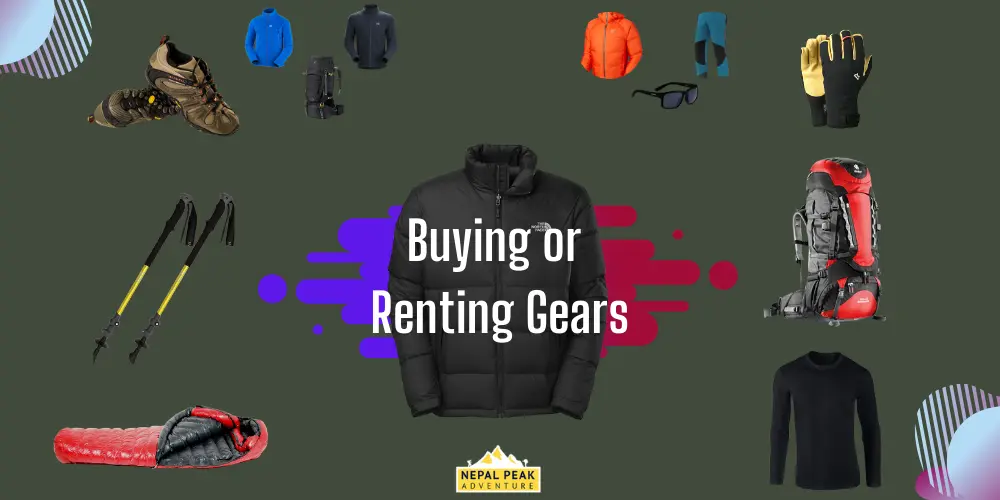
- After the briefing, you will have the chance to review and rent any trekking gear you may need. We typically provide options for renting equipment like sleeping bags, down jackets, trekking poles, and more.
- Ensure that the rented gear fits well and meets your comfort and safety requirements.
Introduction to Kathmandu:
- If time permits, you may take a short orientation walk around Kathmandu, exploring nearby areas and becoming familiar with the local environment.
- This provides an opportunity to experience the vibrant culture and atmosphere of the bustling capital.
Dinner and Rest:
- The day concludes with a hearty welcome dinner from NPA, allowing you to savor Nepali cuisine and bond with your fellow trekkers.
Lukla Flight: Ramechhap or Kathmandu
The Lukla flight serves as the beginning of your Everest Base Camp via the Gokyo Valley trek, taking you into the heart of the Khumbu region. However, there are two primary departure points for Lukla flights—Kathmandu and Ramechhap—each with its dynamics and considerations.
Lukla Flight from Kathmandu:
Only during Off-Seasons, there will be a Lukla Flight from Kathmandu which offers the convenience of departing from the capital city, reducing travel time and logistics.
During bad weather, there will be no Lukla Flights, leading to delays or cancellations. Please Note that you should maintain flexibility in your trekking schedule, allowing for adjustments in case of flight delays or cancellations.
Lukla Flight from Ramechhap:
Flight from Ramechhap is fixed during peak season / trekking season.
The journey from Kathmandu to Ramechhap involves an overland transfer of approximately 4-6 hours. This is a scenic drive through rural landscapes, allowing trekkers to experience Nepal beyond the capital.
Lukla Flight Time:
Lukla flights are subject to weather conditions, and disruptions are not uncommon. The availability of flights can vary based on the departure point. However, the first flight always starts at 7:00 am.
Luggage Limit and Costs:
The luggage limit for Lukla Flight is 10 kg luggage and 5 kg hand carry. For every extra weight, you may be charged an additional fee of $1 per kg.
First Day of Your Trek: How to Start Your Trek
The first day of your Everest Base Camp via Gokyo Valley trek is a momentous step into the heart of the Himalayas. As you lace up your boots and embark on this adventure, here's a guide on how to kickstart your trekking experience: Breakfast and Last-Minute Checks:
- The Lukla flight starts at 7:00 am. Conduct a final check of your backpack, ensuring you have all the necessary items and trekking essentials.
- Breakfast will be packed and your journey begins at Ramechhap Manthali Airport or Kathmandu Domestic Airport.
Lukla Flight & Meet Your Guide and Porter:
- As per your flight schedule, you will take off to Lukla Airport via small aircraft that carry not more than 13-15 passengers at a time.
- Your trekking guide and porter, essential companions for your journey, will meet you at the designated meeting point.
Trail Head to Phakding or Namche Bazaar:
- The trail on the first day typically leads to Phakding according to the itinerary.
- The trek from Lukla to Phakding is a gentle descent and easy. However, after Phakding, the trek will be challenging.
Typical Day during Trekking:
The day begins with an early wake-up call, often before sunrise. The fresh mountain air and the promise of stunning views make it worthwhile to rise with the first light.
Before coming for breakfast, pack everything and leave the bag so that the porter can take it with him. Afterward, enjoy a warm cup of tea or coffee in the teahouse or lodge, accompanied by a hearty breakfast, and hit the trail early.
There will be many scenic viewpoints, prayer flags, or traditional stupas to capture in the photo but do not take more time.
Lunch Break:
- We will stop for a Lunch break at a teahouse in midday.
- Engage with local communities, observe daily life, and capture the unique cultural richness of the region.
After lunch, we will again resume our trek to reach the day’s destination and settle into a tea house or lodge, where basic yet cozy accommodations await.
Your guide will conduct an evening briefing, outlining the plan for the next day, discussing acclimatization strategies, and addressing any trek-related information.
Afterward, enjoy a delicious dinner featuring local and trekker-friendly dishes, or choose between different cuisines to meet your taste.
Finally, leave your order for the next morning's breakfast and get a well-deserved rest at your accommodation.
Tips for the Trek:
- Continuously hydrate to combat the effects of altitude and exertion.
- Maintain a steady pace, allowing for acclimatization and enjoyment of the surroundings.
- Embrace the local culture with respect and curiosity, fostering positive interactions.
Understanding the Accommodation & Meals on Your Trek
As you trek through the enchanting landscapes of the Everest Base Camp via Gokyo Valley, your accommodation and meals play a crucial role in ensuring a comfortable and rewarding experience.Here's an overview of what to expect in terms of lodging and food during your Himalayan adventure & what we offer:
Tea Houses and Lodges:
- Along the trekking route, you'll primarily stay in tea houses or lodges. These are simple, family-run establishments that offer basic yet cozy accommodations.
- With Nepal Peak Adventure, you get 5 Nights in a quality tea house that has a Hot Shower & Attached Bathroom. ( 1 night in Phakding, 3 night in Namche, & 1 night in Lukla).
- As other area has only basic accommodations, your 9 days will be in those basic accommodations.
Meals:
- Meals in tea houses are hearty and designed to replenish your energy after a day of trekking. Expect a mix of local and international dishes, often featuring rice, noodles, soups, and seasonal vegetables.
- Popular items include dal Bhat (lentil soup with rice), momos (dumplings), pasta, and a variety of snacks. The menu caters to both vegetarian and non-vegetarian preferences.
Breakfast:
- Breakfasts typically include options like eggs, toast, porridge, muesli, and local specialties. It's an essential meal to kickstart your day's trek with sustained energy.
Water and Hydration:
- Tea houses provide safe drinking water, which can be refilled using water purification tablets or by purchasing bottled water along the way.
Insight to Local culture & Understanding them
Trekking is not only about immersing in the breathtaking natural beauties but also about immersing yourself in the rich tapestry of local culture. The Sherpa community, renowned for their warmth and hospitality, welcomes trekkers with open hearts. If you want to greet them, use “Namaste” which symbolizes respect and acknowledgment as well as a welcoming gesture. While many locals understand English, learning a few basic Nepali phrases adds a personal touch. Simple greetings and expressions can go a long way in building connections.
Similarly, the Khumbu region is dotted with ancient monasteries, such as the Tengboche Monastery. If your trek coincides with local festivals, consider attending the celebrations.
Festivals like Mani Rimdu are vibrant occasions that provide a window into Sherpa customs, dances, and religious ceremonies.
Seek permission before taking photographs of individuals, particularly in more intimate settings. In conclusion, understanding of local Sherpa culture adds a profound dimension to your Everest Base Camp via the Gokyo Valley trek.
Beyond the physical challenge and awe-inspiring scenery, it is the connections forged with the people of the Himalayas that make the journey truly transformative.
About the life of Guide & Porter
In the realm of Himalayan trekking, guides and porters are not just essential roles; they are the backbone of the trekking experience. Their lives intertwine with the trails, carrying the weight of logistics and providing invaluable support to trekkers. Let's delve into the intricacies of their lives and the pivotal roles they play:The Guide's Life:
These individuals are not merely navigators of trails but also cultural ambassadors, storytellers, and safety guardians. From securing permits to arranging accommodation, guides handle logistical aspects, allowing trekkers to focus on the journey.
Why is it best to have a guide?
Navigational Expertise: Guides possess an intricate knowledge of the trails, ensuring trekkers stay on the right path and navigate challenging terrains.
Cultural Interpreter: Acting as cultural interpreters, guides offer insights into local customs, traditions, and share stories about the Sherpa way of life.
Safety Assurance: Guides are trained in first aid and altitude-related issues, providing a safety net for trekkers in case of emergencies.
Skills Guides Bring to the Trek:
- Guides often possess multilingual skills, facilitating clear communication between trekkers and locals.
- Proficient in map reading and GPS usage, guides ensure a smooth and secure journey along the trails. Well-versed in handling unexpected situations, guides play a crucial role in crisis management, whether it be sudden weather changes or health concerns.
- Guides offer a bridge between trekkers and the local culture, fostering meaningful interactions and a deeper understanding of the region.
The Porter's Contribution:
Porters, the unsung heroes of the trek, shoulder the physical demands of carrying trekking gear, supplies, and even trekkers' backpacks, allowing them to trek with less load.
Porter's Contribution to the Trek:
- Porters carry heavy loads, ensuring trekkers can focus on the trek itself without the burden of excessive weight.
- Porters assist in setting up camp, including assembling tents and arranging necessary equipment for trekkers' comfort. (When necessary)
How much to Tip Guide & Porter
Tipping is a customary practice in the trekking community, a heartfelt way to show gratitude for the dedication and support provided by guides and porters throughout your Everest Base Camp via the Gokyo Valley trek.
However, if you want to tip a guide & porter then here is a guideline:
- On average, trekkers often tip guides between USD 10 to USD 15 per day. This amount can be adjusted based on your overall satisfaction, the duration of the trek, and the complexity of the itinerary.
- A typical tipping range for porters is USD 5 to USD 10 per day. Adjustments can be made based on the weight of the load carried and the overall difficulty of the trek.
- If your guide demonstrated exceptional knowledge, navigational skills, and provided insightful cultural information, consider a higher tip.
- If your porter carried a heavier load or went above and beyond, a higher tip is a generous way to express appreciation.
When to Tip a guide and porter:
Tipping is typically done at the end of the trek, either on the last day or during a farewell ceremony. This allows you to assess the overall experience before expressing your appreciation.
After Completion of Your Trek
As you near the end of your Everest Base Camp walk via Gokyo Valley, you will experience a range of emotions, including a sense of accomplishment, togetherness, and a hint of nostalgia for the spectacular journey across the Himalayas. Thus, here's what you can anticipate after completing your trek:
Farewell Dinner:
To celebrate the successful completion of the trek and the bonds forged along the way, a farewell dinner will be held by Nepal Peak Adventure in Kathmandu. This is an opportunity to share stories, reflect on the journey, and express gratitude to the trekking team, including guides and porters.
Certificate of Achievement Distribution:
To honor the accomplishment of reaching Everest Base Camp via Gokyo Valley, we will present each trekkers with a Certificate of Achievement. We hope that this symbolic recognition adds a special touch to the trekking experience, serving as a tangible memento of your Himalayan adventure with us.
Departure Day:
The final day marks your departure from us & the end of our service. After a satisfying breakfast, you'll bid farewell to your hotel, and make your way to the point of departure, often Kathmandu Tribhuvan International Airport.
However, if you need our assistance again then we will be happy to assist you in your journey.
Useful Information to Beginners:
Possibility of Altitude Sickness
Altitude sickness is a potential challenge that trekkers may face when venturing into the higher elevations of the Himalayas, particularly during a trek like Everest Base Camp via Gokyo Valley.
Understanding what altitude sickness is and how beginners are exposed to this threat is crucial for a safe and enjoyable trekking experience.
What is Altitude Sickness?
Altitude sickness, also known as acute mountain sickness (AMS), is a condition that can affect individuals when ascending to higher elevations too quickly. It occurs due to the reduced air pressure and lower oxygen levels at higher altitudes. The symptoms can range from mild to severe and may include headaches, nausea, dizziness, fatigue, and difficulty sleeping.
How Beginners are Exposed to the Threat:
Beginner trekkers are often enthusiastic and may attempt to ascend to higher elevations quickly without allowing their bodies to acclimatize. Rapid ascents increase the risk of altitude sickness.
Inadequate Acclimatization:
Acclimatization is the process by which the body adjusts to the decreasing oxygen levels at higher altitudes. Insufficient acclimatization, such as ascending too rapidly or skipping acclimatization days, puts trekkers at greater risk.
Ignoring Symptoms:
In some cases, trekkers, especially beginners, may ignore the early symptoms of altitude sickness, attributing them to fatigue or normal exertion. Ignoring these warning signs can lead to more severe forms of the condition.
Dehydration:
Dehydration can exacerbate the effects of altitude sickness. In the dry, mountainous terrain, trekkers need to stay well-hydrated to support their bodies in adapting to the altitude.
Mitigating the Risk of Altitude Sickness:
Gradual Ascent: Ascend gradually, allowing your body to acclimatize to the changing altitude.
Hydration: Stay well-hydrated by drinking plenty of fluids, preferably water, to combat the dry mountain air.
Recognizing Symptoms: Be aware of the symptoms of altitude sickness and communicate any discomfort or unusual sensations to your trekking guide promptly.
Acclimatization Days: Respect acclimatization days in your trekking itinerary. These days are strategically included to allow your body to adjust to higher altitudes.
Insurance for the Everest Base Camp via Gokyo Lake Trek
Travel Insurance, also known as Trekking Insurance in Nepal is essential to prioritize your safety. Securing comprehensive travel insurance is a crucial aspect of responsible trekking in the Himalayas. Here's a guide on the importance of insurance and what aspects it should cover:
Why Insurance Matters:
The Himalayas, while breathtaking, present various challenges and unpredictable conditions. Thus, Travel insurance acts as a safety net, providing financial coverage and support in case of unforeseen circumstances during your trek.
Similarly, when selecting insurance for the Everest Base Camp via Gokyo Lake trek, ensure it covers the following key aspects:
- Medical Evacuation and Treatment
- Trip Cancellation and Interruption
- Lost or Stolen Belongings
- Delayed or Lost Baggage
- Accidental loss and Dismemberment
- High-Altitude and Adventure Sports Coverage
Before purchasing insurance, carefully read and understand the policy terms and conditions. Pay attention to coverage limits, exclusions, and any pre-existing conditions that might affect your coverage.
How hard is the Gokyo Valley Trek?
Let’s say the different levels of difficulty are:
- Easy / Beginner Level ( No Training Needed)
- Normal / Intermediate Level ( Trekkers with Enough Preparation & Training)
- Challenging / Expert ( Trekkers who have done trekking above 4,000m)
- Hard / Professional (Those who have prior experience in high altitudes above 5,500m)
Still, it is difficult to answer the question about how hard is Everest Base Camp via Gokyo Valley Trek. Some people may find it challenging while some trekkers can find it hard in terms of difficulty. However, on average, this trek is considered as challenging level.
What makes this trek Challenging Trek?
The trek involves ascending to high altitudes, reaching Gokyo Ri at over 17,575 feet (5,357m), Cho La Pass at over 17,782 feet (5,420m), Everest Base Camp at 17,598 feet(5,364m) & Kalapatthar at 18,517 feet (5,644m).
Training Needed for the EBC via Gokyo trek
Adequate training ensures that trekkers can navigate the challenging terrain, high altitudes, and varying weather conditions. And, Everest Base Camp via Gokyo Valley Trek is not exceptional, thus it can be summited with proper training.
Here's a comprehensive guide on the training needed for a successful EBC via Gokyo trek:
Cardiovascular Fitness:
Engage in aerobic exercises to improve cardiovascular endurance. Activities like running, jogging, cycling, and swimming help build stamina for sustained trekking.
Strength Training:
Strengthen core muscles, legs, and upper body to handle the demands of uneven terrain and uphill climbs. Incorporate exercises like squats, lunges, planks, and weight training.
Endurance Building:
Extend the duration and intensity of your workouts gradually. Long-distance walking or hiking on varied terrains helps build endurance essential for daily trekking.
Altitude Simulation:
If possible, simulate high-altitude conditions by training at elevated locations or using altitude training masks. This aids in acclimatization and prepares the body for reduced oxygen levels.
Backpack Training
Train with a loaded backpack to simulate the weight you'll carry during the trek. Gradually increase the load to build strength and get accustomed to trekking with a backpack.
Mental Preparation:
Develop mental resilience through mindfulness practices or activities like meditation and yoga. Mental strength is crucial for overcoming challenges and maintaining a positive mindset during the trek.
Hydration and Nutrition:
Practice proper hydration and nutrition during your training. Learn about the types of snacks and meals that provide sustained energy, as this knowledge will be valuable during the trek.
Consultation with Healthcare Professional:
Before starting any training program, consult with a healthcare professional, especially if you have pre-existing medical conditions. Obtain guidance on tailoring your training to your individual health needs.
Consistency is Key:
Be consistent in your training routine. Regular workouts, progressively increasing intensity, and addressing weaknesses will significantly enhance your preparedness for the EBC via Gokyo trek.
Best Time for Everest Base Camp via Gokyo Valley Trek
Selecting the right time to embark on this journey is crucial for a safe and enjoyable experience. The best time to undertake the Everest Base Camp via Gokyo Valley Trek are:
Pre-Monsoon (Spring) - Best Time: March to May:
- Spring is considered the optimal time for the trek. The weather is generally stable, with mild temperatures and clear skies.
- The trail comes alive with vibrant rhododendron blooms, and the entire region is a spectacle of colors.
- Daytime temperatures range from 15°C to 20°C (59°F to 68°F), providing comfortable trekking conditions.
- Clear visibility allows trekkers to witness breathtaking panoramic views of the Himalayan peaks.
Post-Monsoon (Autumn) - Recommended Time: September to November:
- Autumn is another excellent time for the EBC via Gokyo Valley Trek. The skies are clear, and the weather is stable after the monsoon season.
- This period is the peak trekking season, attracting a higher number of trekkers. Bookings for accommodations and permits are advisable.
- Daytime temperatures range from 12°C to 20°C (54°F to 68°F), offering comfortable trekking conditions.
Besides these two peak seasons, if you are considering trekking in Winter & Monsoon then here are some details:
Winter - Possible, but Challenging: December to February:
- Winter brings colder temperatures, and higher elevations experience sub-zero temperatures. Days are generally clear, but snowfall is possible.
- The winter trek presents challenges such as colder temperatures, icy trails, and a higher risk of flight cancellations to and from Lukla due to weather conditions.
- The trail is less crowded during winter, providing a quieter trekking experience.
Pre-Monsoon (Summer) - Less Recommended: June to August:
- Summer is the monsoon season, characterized by heavy rainfall, cloudy skies, and the possibility of landslides.
- Trekking during the monsoon brings challenges like slippery trails, leeches, and reduced visibility of mountain panoramas.
In conclusion, the best time for the Everest Base Camp via Gokyo Valley Trek is during the pre-monsoon (spring) and post-monsoon (autumn) seasons when the weather is stable, the skies are clear, and the trekking conditions are most favorable.
About Booking Process: Book Now Pay Later
The Everest Base Camp (EBC) via Gokyo Valley Trek, is now more accessible with our "Book Now, Pay Later" booking process. We understand the importance of flexibility and convenience in planning your trekking expedition.
Here’s how our Book Now Pay Later process goes:
- Begin your booking process by reaching out to our dedicated team through our website or contact channels. Share your trekking preferences, group size, and desired travel dates.
- Engage in personalized discussions with our experienced trekking consultants. We'll tailor the itinerary to suit your preferences, ensuring you have the best possible trekking experience.
- Once your itinerary is finalized, we will promptly confirm the availability of permits, accommodations, and other essential elements for your chosen trekking dates.
- Secure your trekking reservation with a minimal initial deposit. Our "Book Now, Pay Later" approach allows you to confirm your spot without immediate full payment, offering financial flexibility.
- Upon successful confirmation of your initial deposit and subsequent payments, you will receive a detailed booking confirmation. This document outlines your itinerary, accommodations, permits, and other relevant information.
